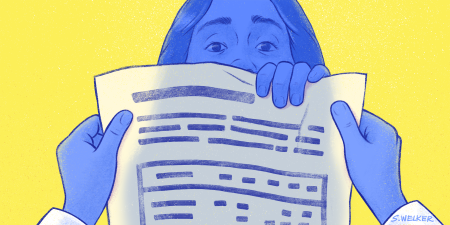Abstract
Following a case in which a patient’s self-report contradicts imaging data, this commentary considers how patient-clinician communication, including an assessment of and accommodations for maximizing health literacy and shared decision making, can elucidate a patient’s values and preferences. Patients’ perceptions of how much input they have in making their health decisions influences the patient-clinician therapeutic alliance and outcomes and can support patients’ physical and emotional well-being.
Case
JM is a 46-year-old woman who has lived with primary progressive multiple sclerosis (PPMS) for over 20 years. She visits her neurologist, Dr N, regularly to review symptoms (mainly chronic fatigue, intermittent pain, right-side weakness, difficulty with word finding and recall, and spasticity) and revisit therapeutic options. She gets a magnetic resonance image (MRI) every year when she visits her neurologist and had her most recent MRI one month ago. JM has been taking glatiramer acetate injections as directed for the last 7 years, during which time her symptoms have not worsened and fewer than 5 new plaques have been visible on imaging during this therapy.
JM has been ambulating without gait disturbances and states that she’s been feeling better. JM attributes feeling better to a now 3-month-old regimen of daily exercise and eating a Mediterranean diet. “After a month of my new exercise and diet routine, I stopped the glatiramer acetate injections, and I feel so freed from having to do that to myself. And I feel terrific.”
“I’m so glad you’re feeling better,” Dr N says. On physical exam, JM’s symptoms have not worsened, and Dr N notices that JM certainly looks energized and content. Upon reviewing her MRI, however, Dr N noticed 2 new plaque lesions in her motor cortex, and she wonders what to say next.
Commentary
A 1982 President’s Commission for the Study of Ethical Problems in Medicine and Biomedical and Behavioral Research identified shared decision making as the ideal manner of reaching patient-clinician consensus on a treatment plan following a discussion to ensure informed consent.1 Given patients’ vulnerability, the patient-physician power differential, and diagnostic or therapeutic uncertainty, tending to patients’ emotional and relational well-being through shared decision making is a crucial component of patient care.2 In December 1990, Congress passed the Patient Self-Determination Act, which went into effect in 1991 and included a mandate to provide written information to patients regarding their right to make health care decisions and the right to refuse treatment.3 One of the clinical tools to arise from this act was the patient decision aid—a written, auditory, or visual summary of information to promote patient education and improve health literacy. In conjunction with shared decision making, decision aids can be means to increase patient autonomy. In 2010, Section 3506 of the Affordable Care Act included a Program to Facilitate Shared Decision Making, but little was done to implement its use.4 In the case of JM and Dr N, it is crucial to utilize the tools of decision aids and shared decision making in formulating a care plan that JM can accept.
Shared Decision Making
Clinical care involves a melding of patient narratives with objective data, and both should be documented and weighed in formulating clinical recommendations. An abnormality identified in empirical data without associated subjective symptoms is often called an incidental finding. The weight given to such a finding and the need to treat depends entirely on the risk the abnormality carries for the patient who may be asymptomatic. In cases in which treatment is imperative, it is important for the clinician to invest time in explaining to the patient why they should be treated despite the lack of symptoms. Failure to do so might contribute to patient nonadherence. If the patient has a novel or understudied disease, the extent of therapeutic benefit of available interventions may be unknown or relatively modest. In that case, there is a further tipping of the scales toward patient autonomy, the bioethical principle underlying shared decision making. The caveat is the presumption that the patient has the health literacy and decisional capacity to give informed consent based on a thorough discussion of the risks and benefits of proposed treatment options.
Health literacy is a modifiable social determinant of health that can be improved through dedicated patient education and training. Greater health literacy allows for greater patient autonomy in shared decision making.5 As patients improve their health literacy, they increase their knowledge of their disease, learn how to better manage their condition, and become more engaged in discussions regarding their care. Simplifying information is one way to help patients with lower healthy literacy participate in shared decision making. However, patients still need the cognitive, social, and communication skills to partake in shared decision making. These considerations speak to the principles of beneficence and nonmaleficence along with autonomy.
Clinical Considerations
Because JM has disease activity based not on clinical symptoms but on an MRI, her PPMS would be categorized as active but without progression according to the most recent guidelines.6 Both her age (less than 55 years old) and the presence of new lesions on an MRI would make her a candidate for ocrelizumab, the first US Food and Drug Administration (FDA)-approved treatment for PPMS.7 A double-blind, randomized-controlled trial of ocrelizumab vs placebo found modest effects, with 6% fewer patients on ocrelizumab than on the placebo having confirmed disease progression at both 12 and 24 weeks.8,9 Additional benefits of ocrelizumab included improved performance on the 25-foot hall walk test, decreased radiographic burden of disease, and decreased overall loss of brain volume relative to the placebo. The side effects of long-term use of ocrelizumab included higher risk of infections, including influenza, herpes, and shingles.8,9 The immunosuppressive effects of ocrelizumab affect not only the risk of infection, but also the body’s ability to keep cancer at bay. Thus, patients receiving ocrelizumab had a higher risk of cancer than those receiving the placebo.8
Health literacy is a modifiable social determinant of health that can be improved through dedicated education.
In considering the use of ocrelizumab to treat PPMS, clinicians need to weigh the slightly lower rate of disease progression against the higher risk of complications, including slightly higher rates of infection relative to placebo (71.4% v 69.9% overall and 10.9% v 5.9% for upper respiratory tract infections), and a small risk of breast cancer (less than 1% of cases).9 It could be reasonable to treat a patient with ocrelizumab whose goal is to slow the progression of PPMS, no matter the risk or cost, especially if the patient is young and has active disease, both clinically and radiographically. In contrast, by discontinuing her treatment, JM has made clear her preference to be off medication. What isn’t clear is if she understands the risks and benefits of doing so. Having JM “teach back” her understanding of risks vs benefits following a detailed discussion of the pros and cons of remaining off therapy vs resuming glatiramer acetate or switching to ocrelizumab would be essential for Dr N to assess JM’s understanding of the treatment. It would also provide an opportunity to correct any misunderstandings and to fill in any residual knowledge gaps.
To better understand JM’s preferences and values regarding treatment, Dr N could ask questions geared towards eliciting her hopes and fears regarding treatment at present and in the future. Fears of side effects would be especially important for Dr N to address in order to empathize with her concerns, address any fears that are disproportionate to their likelihood of occurrence (eg, by giving statistics on the likelihood of the various side effects), and educate her on the side effects she’d most likely encounter, potential treatments for or the reversibility of the side effects, and the importance of informing her of any side effects so they can address the issues as they arise. Dr N’s conversation with JM should also focus on the benefits of treatment and, more specifically, on how these benefits might help JM attain her top treatment-related goals, such as avoiding medicines with fatal side effects, maintaining or improving memory, preventing brain atrophy, maintaining her ability to walk, maintaining her cognition, staying relatively healthy, avoiding vision loss, minimizing weakness and deconditioning, and remaining as active as possible.10
Following this discussion, if JM continued to decline treatment because the risks were too high or treatment wasn’t in keeping with her goals, it would be reasonable for her to forgo ocrelizumab, given her lack of clinical symptoms combined with the drug’s modest benefit and risk of infectious disease and cancer. JM developed 5 lesions over 7 years while on therapy, averaging under one lesion per year, so an additional 2 lesions in the year since she self-discontinued therapy represents a moderate but not alarming increase in frequency of plaques. If JM had a more rapid objective decompensation off therapy and if PPMS had a highly effective treatment with minimal side effects, then Dr N would have a stronger basis for recommending that JM adhere to the proposed treatment regimen. In the absence of such a highly beneficial treatment, it is even more important for Dr N to facilitate shared decision making based on JM’s own values and preferences, as those are the main factors in the treatment decision equation. If her disease continues to progress—either radiographically or with new symptoms—the risks vs benefits of treatment should be readdressed with the patient at that point. When clinical data run counter to patient self-report, allowing extra time for a detailed review of that data, comparing the patient’s test results with normal values, and even bringing up the concerning imaging findings for the patient to see for herself could help the patient better understand the physician’s concerns, the disconnect between objective data and subjective symptom report, and the need for treatment despite minimal symptoms.
Decision Aids
One effective means to promote shared decision making is to use patient decision aids in written, video, or online interactive formats that delineate the various care options, the frequency of side effects or complications, and potential benefits and costs. Patient decision aides should be written at an eighth-grade literacy level and, additionally, should be brief and readable.4,5 Dr N should provide JM with decision aids regarding her treatment options as a basis for further discussions of care to uphold her values and preferences. Shared decision making has numerous potential benefits, including increasing knowledge, decreasing anxiety, improving outcomes, and decreasing costs, as well as better aligning care with patient preferences and values.4
In MS, the initiation, continuation, and withdrawal of treatment are key decisions to be made over the waxing and waning course of the disease. One study found that 80% of patients with MS prefer an autonomous role in treatment decisions.11 Despite this overwhelming patient preference, clinicians decide whether to involve patients with MS in the decision-making process. In cases in which patients’ wishes are not factored into the treatment decision, the only means they have to voice their opposition is through willful nonadherence.12 In offering a treatment recommendation to JM, Dr N should rely on both the patient’s self-report of symptoms and the MRI showing the 2 new plaques, especially as both are factored into the assessment regarding disease progression. Dr N also should set the stage for a plan B if the patient develops more plaques on an MRI or more clinically apparent symptoms. Dr N and JN could together set a threshold above which they both agree that treatment would be initiated because the likelihood of benefit would outweigh the risks. Doing so would help balance respect for her autonomy with beneficence and would avoid significant harm.
Available decision aids to enhance patients’ understanding of the risks and benefits of treating their MS include a 4-hour education program as well as an educational leaflet on relapse treatment options.11 Another approach is decision coaching by qualified MS nurses that is tailored to the needs of a particular patient. All the approaches are contingent on a trusting relationship between the patient and clinician.12
One study demonstrated that patients’ perception of their role in decision-making processes can improve therapeutic outcomes independently of what would be expected based solely on improved adherence to treatment. Specifically, a “sustained partnership” approach to treatment decisions had beneficial effects on emotional well-being, symptom burden, and physiologic parameters.13 In the case of JM, the harms of stopping her glatiramer acetate injections may be diminished and the benefits of adjusting her diet and exercise may be augmented disproportionately to what could otherwise be expected due to the patient’s beliefs regarding how these changes will impact her health.
Conclusion
Overall, shared decision making, a process rooted in upholding a patient’s autonomy, is known to be beneficial but is not practiced as much as it should be. Health literacy goes hand in hand with the capacity to participate in shared decision making and can be improved through patient decision aids. It is important for clinicians to invest time in educating patients to help inform and empower them to make the best treatment decisions for themselves. A crucial step in shared decision making is discussing patients’ values and goals for their clinical care. In the case, JM’s discussion with Dr N revealed that, barring a highly effective or even curative treatment, JM prefers maintaining her health through diet and exercise. Furthermore, she’d like to avoid treatment in the absence of symptoms, least of all treatment options with infectious and oncologic risks. JM understands that, despite her lack of symptoms, she has active disease, as evident from her MRI, and this disease process could be mildly mitigated by ocrelizumab. Accordingly, it would be reasonable for JM to defer the only FDA-approved treatment for her disease until her symptoms reach a threshold agreed upon by JM and Dr N. Allowing the patient’s self-report narrative to trump empirical data in this type of a case could improve many outcomes, including the patient’s emotional well-being and therapeutic relationship with her doctor, as well as her physical well-being and symptom burden. These benefits occur independently of adherence to any specific treatment regimen and make a strong case for promoting shared decision making as much as possible.
References
-
President’s Commission for the Study of Ethical Problems in Medicine and Biomedical and Behavioral Research. Making Health Care Decisions: A Report on the Ethical and Legal Implications of Informed Consent in the Patient-Practitioner Relationship, Volume 1: Report. US Government Printing Office; 1982. Accessed February 14, 2021. https://repository.library.georgetown.edu/bitstream/handle/10822/559354/making_health_care_decisions.pdf?sequence=1&isAllowed=y
- Gulbrandsen P, Clayman ML, Beach MC, et al. Shared decision-making as an existential journey: aiming for restored autonomous capacity. Patient Educ Couns. 2016;99(9):1505-1510.
-
Patient Self-Determination Act, HR 4449, 101st Cong, 2nd Sess (1990).
- Oshima Lee E, Emanuel EJ. Shared decision making to improve care and reduce costs. N Engl J Med. 2013;368(1):6-8.
- Muskat DM, Shepherd HL, Nutbeam D, Trevena L, McCaffery KJ. Health literacy and shared decision-making: exploring the relationship to enable meaningful patient engagement in healthcare. J Gen Intern Med. 2021;36(2):521-524.
- Lublin FD, Reingold SC, Cohen JA, et al. Defining the clinical course of multiple sclerosis: the 2013 revisions. Neurology. 2014;83(3):278-286.
-
FDA approves new drug to treat multiple sclerosis. News release. US Food and Drug Administration; March 29, 2017. Accessed March 1, 2021. https://www.fda.gov/NewsEvents/Newsroom/PressAnnouncements/ucm549325.htm
-
Olek MJ, Mowry E. Treatment of primary progressive multiple sclerosis in adults. UpToDate®. December 8, 2020.
-
Montalban X, Hauser SL, Kappos L, et al; ORATORIO Clinical Investigators. Ocrelizumab versus placebo in primary progressive multiple sclerosis. N Engl J Med. 2017;376(3):209-220.
- Col NF, Solomon AJ, Springmann V, et al. Whose preferences matter? A patient-centered approach for eliciting treatment goals. Med Decis Making. 2018;38(1):44-55.
-
Heesen C, Kasper J, Köpke S, Richter T, Segal J, Mühlhauser I. Informed shared decision making in multiple sclerosis—inevitable or impossible? J Neurol Sci. 2007;259(1-2):109-117.
- Heesen C, Rahn AC. Guest editorial: shared decision making in managing multiple sclerosis: revisiting the research agenda. Int J MS Care. 2018;20(6):v-vi.
- Brody H, Colloca L, Miller FG. The placebo phenomenon: implications for the ethics of shared decision-making. J Gen Intern Med. 2012;27(6):739-742.



